
Lewis Wallace was an American lawyer, Union general in the American Civil War, governor of New Mexico Territory, politician, diplomat, and author from Indiana. Among his novels and biographies, Wallace is best known for his historical adventure story, Ben-Hur: A Tale of the Christ (1880), a bestselling novel that has been called "the most influential Christian book of the nineteenth century."
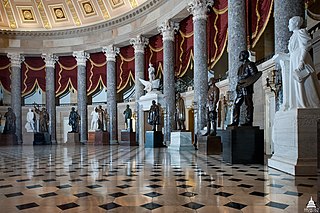
The National Statuary Hall is a chamber in the United States Capitol devoted to sculptures of prominent Americans. The hall, also known as the Old Hall of the House, is a large, two-story, semicircular room with a second story gallery along the curved perimeter. It is located immediately south of the Rotunda. The meeting place of the U.S. House of Representatives for nearly 50 years (1807–1857), after a few years of disuse in 1864 it was repurposed as a statuary hall; this is when the National Statuary Hall Collection was established. By 1933, the collection had outgrown this single room, and a number of statues are placed elsewhere within the Capitol.

Jo Davidson was an American sculptor. Although he specialized in realistic, intense portrait busts, Davidson did not require his subjects to formally pose for him; rather, he observed and spoke with them. He worked primarily with clay, while the final products were typically cast in terra-cotta or bronze, or carved from marble.

Franklin Bachelder Simmons was a prominent American sculptor of the nineteenth century. Three of his statues are in the National Statuary Hall Collection, three of his busts are in the United States Senate Vice Presidential Bust Collection, and his statue of Ulysses S. Grant is in the United States Capitol Rotunda.
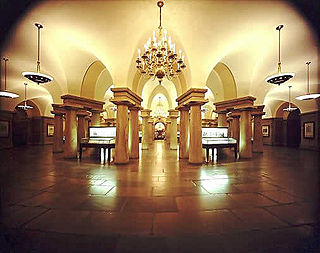
The United States Capitol crypt is the large circular room filled with forty neoclassical Doric columns directly beneath the United States Capitol rotunda. It was built originally to support the rotunda as well as offer an entrance to Washington's Tomb. It currently serves as a museum and a repository for thirteen statues of the National Statuary Hall Collection.

Belle Marshall KinneyScholz (1890–1959) was an American sculptor, born in Tennessee who worked and died in New York state.

Andrew O'Connor was an American-Irish sculptor whose work is represented in museums in America, Ireland, Britain and France.
Anne Whitney created two public statues of Samuel Adams. One, made in 1876, resides in the National Statuary Hall Collection in the US Capitol, Washington, D.C. The other, made in 1880, is located in front of Faneuil Hall Plaza in Boston.

George L. Shoup is a marble sculpture of George L. Shoup created by Frederick Triebel and placed in the National Statuary Hall Collection in the Capitol Building in Washington, D.C., one of the two statues there from Idaho. It was dedicated in 1910. The work cost $7,500 and was unveiled in Washington on January 15, 1910.

Henry Mower Rice is a marble sculpture of Henry Mower Rice created by Frederick Triebel and placed in the National Statuary Hall Collection in the Capitol Building in Washington, D.C., one of the two statues there from the State of Minnesota. It was dedicated in 1916. The work cost $7,500 and was unveiled in Washington on February 8, 1916.

James Paul Clarke is a marble sculpture depicting the American politician of the same name by Pompeo Coppini, installed in the United States Capitol's National Statuary Hall Collection, in Washington, D.C., as one of two statues gifted by the U.S. state of Arkansas. The 6 foot 10 inch tall statue was placed in the Hall in 1921. The work cost $7,500. and was unveiled in Washington in 1921.

Henry Clay is a 1929 bronze sculpture by Charles Henry Niehaus depicting the lawyer and politician Henry Clay, installed in the United States Capitol in Washington D.C. as part of the National Statuary Hall Collection. It is one of two statues donated by the state of Kentucky. The statue was accepted into the collection by Virgil Chapman on March 3, 1929.

John Winthrop is a marble sculpture of John Winthrop by Richard Saltonstall Greenough, installed in the United States Capitol, in Washington D.C., as part of the National Statuary Hall Collection. It is one of two statues donated by the state of Massachusetts. The statue was accepted in the collection by George Frisbie Hoar on December 19, 1876.

Andrew Jackson is a 1928 bronze sculpture of Andrew Jackson by Belle Kinney Scholz and Leopold Scholz, installed in the United States Capitol, in Washington D.C., as part of the National Statuary Hall Collection. It is one of two statues donated by the state of Tennessee. The statue was accepted into the collection by Senator Kenneth McKellar on April 16, 1928.

Robert R. Livingston is an 1875 bronze sculpture of Robert R. Livingston, one of the Founding Fathers of the United States, executed by the New York born sculptor Erastus Dow Palmer. The state is installed in the United States Capitol, in Washington, D.C., as part of the National Statuary Hall Collection. It is one of two statues donated by the state of New York.
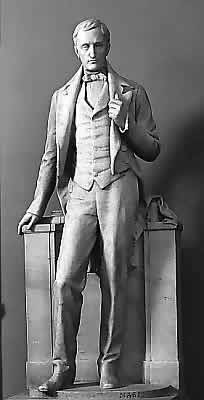
Crawford Long is a 1926 marble sculpture depicting the American surgeon and pharmacist of the same name by J. Massey Rhind, installed in the United States Capitol, in Washington, D.C., as part of the National Statuary Hall Collection. It is one of two statues donated by the U.S. state of Georgia.

Jacques Marquette is a statue by Gaetano Trentanove of Jacques Marquette, the best-known version being the 1896 marble one installed in the National Statuary Hall Collection in the Capitol in Washington D.C.
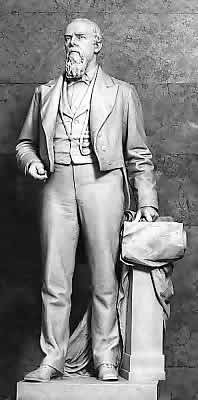
Oliver P. Morton is a 1900 marble statue of Governor Oliver P. Morton by Charles Henry Niehaus installed in the United States Capitol, in Washington, D.C., as part of the National Statuary Hall Collection. It is one of two statues donated by the state of Indiana. The statue was accepted into the collection on April 14, 1900, by Indiana Senator Albert J. Beveridge.,
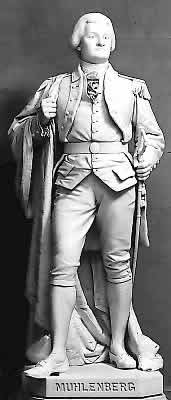
Peter Muhlenberg, or John Peter Gabriel Muhlenberg, is an 1889 marble sculpture depicting the American clergyman, soldier, and politician of the same name by Blanche Nevin, installed in the United States Capitol's crypt, in Washington, D.C., as part of the National Statuary Hall Collection. It is one of two statues donated by the state of Pennsylvania. The statue was accepted into the collection on February 28, 1889, by Pennsylvania Congressman Daniel Ermentrout.

John Campbell Greenway is a 1930 bronze statue of John Campbell Greenway by Gutzon Borglum, one version of which was installed in the United States Capitol, in Washington D.C., as part of the National Statuary Hall Collection. It was one of two statues donated by the state of Arizona. The sculpture was unveiled by Senator Henry Ashurst of Arizona on May 24, 1930.



















